

A B C D E F G H I J K L M N O P Q R S T U V W X Y Z
|
Page 1: Pacific - Para Academy Page 2: Para Assault Course - Pearl Harbour Page 3: A Peasant's Tale - P-47: The Freedom Fighter Page 4: Phantomas Saga: Infinity - Ping Pong Page 5: Pipe Mania - Play Your Cards Right Page 6: The Plot - Pop-Up |
Page 7: Postman Pat - Predator 2 Page 8: Prehistorik - Pro Golf Simulator Page 9: Prohibition - Psycho Hopper Page 10: Psycho Pig UXB - Purple Saturn Day Page 11: Puzznic - Python Pete |
 |
Para Assault Course
(Zeppelin, 1988) As you may have guessed, this is a joystick waggling frenzy in which you try to complete some gruelling assault courses as quickly as possible. After a few goes, you'll probably have built up your muscles sufficiently to attempt the real thing! Among the obstacles you will face are walls, ramps, rivers, monkey bars and logs, and you'll also have to swim through a water-filled pipe and crawl through barbed wire – and unlike the other obstacles, if you get these ones wrong, the game is over. You can use the keyboard, but it doesn't work very well and makes the game a bit tougher. The graphics are OK, but there are no sound effects or music to accompany the game at all, and I dislike joystick waggling games anyway. 4 |
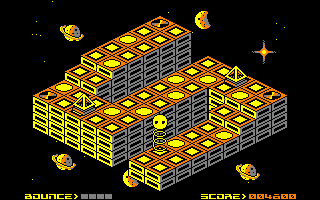 |
Parabola
(Firebird, 1987) Bruce is a springy creature who has to bounce his way across a grid, starting from one corner and attempting to reach the opposite corner. Each square on the grid represents one stage, in which you must bounce around a screen full of moving guardians, collecting some spinning discs. As well as avoiding the guardians, some of the squares are booby-trapped and will cause Bruce to fly into the air and come back to earth with a bang, losing a life. This is a nice and simple isometric arcade-cum-puzzle game, and the graphics are well presented, although movement can be slow, and the sound is fairly limited. If you like puzzle games, though, this is worth a look. 7 |
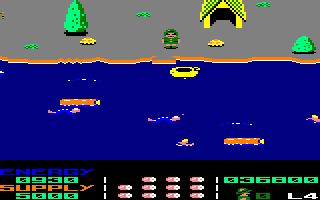 |
Park Patrol
(Firebird, 1987) As a ranger in a national park in America, you have to patrol your area of the park in your canoe and clear it of litter. You must avoid the local wildlife and dodge the logs and swimmers while paddling your canoe. You can also return to your hut to replenish your energy – that is, if the ants haven't taken your food away! There are five levels, and unusually, you can customise the difficulty of each level – nice. The graphics are nothing special, and some of the tunes are irritating, but I think it's an enjoyable little game despite these faults. 7 |
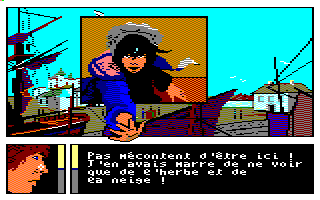 |
This game is the faithful adaptation of the (great) cartoon strip of the same name by François Bourgeon. The story takes place in France, England and Africa during the 18th century. You guide Isabeau, her lover and many other characters through the dangers of the colonial era. The main interest of the game is M. Bourgeon's gorgeous hand drawn graphics, and the style of the original cartoons is perfectly retained. The soundtrack is really good, and underlines the dramatic (and sometimes nearly sensual) atmosphere of the game. The game itself is divided into ten chapters. Every time a character has a choice to make, you must say the right thing in order to progress to the next chapter. However, the game is rather linear; I finished it in five hours (including two hours of loading...) See also: Les Passagers du Vent 2. 5 |
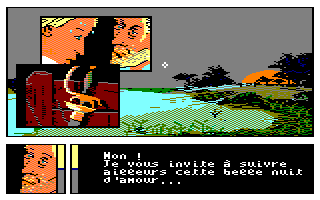 |
Isabeau's lover Hoel has been poisoned by Estienne de Viaroux – one of her companions – and she goes to meet King Kpëngla in Dahomey to see if he can do anything. This game follows the adventures of Isabeau and a group of other people travelling with her, as they try to earn the trust of the king and return to Fort Saint-Louis where Hoel is lying, seriously ill. The format of the game is exactly the same as its predecessor – clicking on character's faces and choosing the correct responses to allow you to progress. However, later on in the game, there are no clues as to whether you have made the right choices. The graphics and music are just as marvellous as those in the original game, and it's more difficult as well. See also: Les Passagers du Vent. 7 |
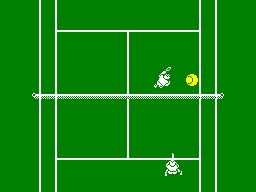 |
Image Works has a passing shot at a tennis game on the CPC. The main difference from most other tennis games on the CPC is that when you serve you are shown a normal view of the court, but when the ball is hit, the game is then played from an overhead view. It's an interesting concept and one that could have worked well, but the actual speed of the gameplay is quite slow. If you are willing to hack it out and have patience you may enjoy it more than I did and go on to become the Grand Slam champion of all four major tennis tournaments. There are no in-game sounds and the in-game graphics are garishly Spectrum-looking. 3 |
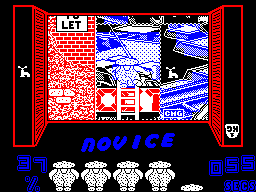 |
Pasteman Pat
(Silverbird, 1989) Nasty Norville and his workers have mixed up all of Pat's posters, so he has to put them back together again by sliding the paper along. Watch out for all of the things that Norville throws at you, or you'll be knocked off your ladder! There are twelve difficulty levels to keep you going, from starters to impossible, and there are several posters that you can use – all of them advertising other Firebird games (although some of them weren't released for the CPC). If you're stuck, try going to the toilets... It's an average sort of game, really, and although the music is good, the graphics and the colour clash show that it's a blatant Spectrum port. 6 |
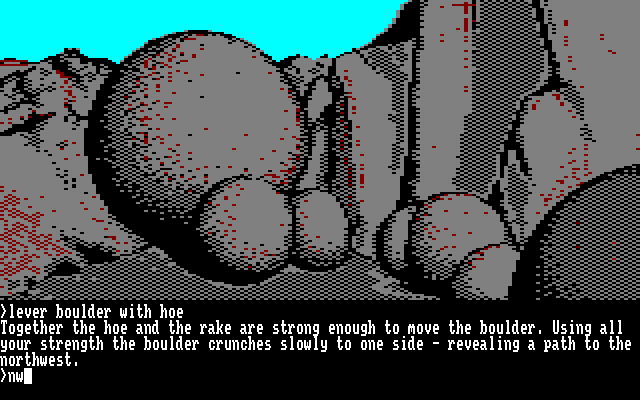 |
The Pawn
(Rainbird/Magnetic Scrolls, 1987) It was just another normal day for you, coming back from the supermarket, when you suddenly end up in the fantasy land of Kerovnia, with a wristband on your forearm which you cannot remove. Then you encounter a magician called Kronos, who asks you to deliver a note to King Erik. Maybe you could ask him about this wristband that you're wearing? Despite the interesting book that comes with the game, which describes the recent history of Kerovnia, the game itself doesn't bear much relation to the events in the book, and the puzzles to be solved seem rather incoherent and unconnected with each other. However, this is reckoned to be one of the best text adventures ever, combining a traditional fantasy adventure with a sense of humour, and the pictures are stunning. 9 |
 |
You play a female cat whose ten kittens are missing. Your aim is to search the city, the alleyways and the forests to find them and return them to your home in the city centre, before Bulldog Billy and his pack come to your home for their nightly fight. Unfortunately, you can only pick up one kitten at a time. However, you can kill the dogs by firing fluff balls at them (!), and if you kill enough of them, you can prevent them from forming a pack. There is also lots of food and other objects, allowing you to maintain your stamina and strength. The graphics are OK, but what is so off-putting about the game is that it is really slow and therefore rather boring, especially with all the walking that you have to do. What's more, there are no sound effects at all! 4 |
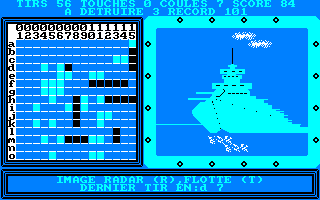 |
Pearl Harbour
(Sprites, 1985) Despite the name, there is no link at all to the bombing of Pearl Harbour in this game. Instead, it's a computerised version of the battleships pen-and-paper game. The computer places a random number of ships on a 15×15 grid, and on each turn, you select which square you want to fire at. If you hit an enemy ship, an animation is displayed, and the aim is to sink all the ships in the fewest number of hits. To aid you, there is a radar which gives you a hint as to where the ships are located, but use it sparingly, as you are penalised each time you use it. The animations are very crudely drawn, and sound effects are limited to a few explosions. The biggest drawback is that there is no option to play a traditional game of battleships against the computer, and a one-player version of battleships isn't much fun. 4 |